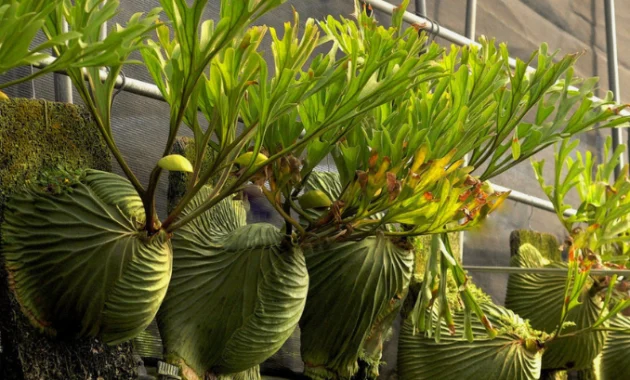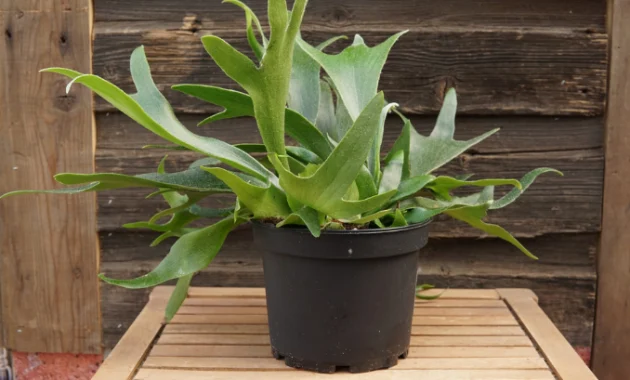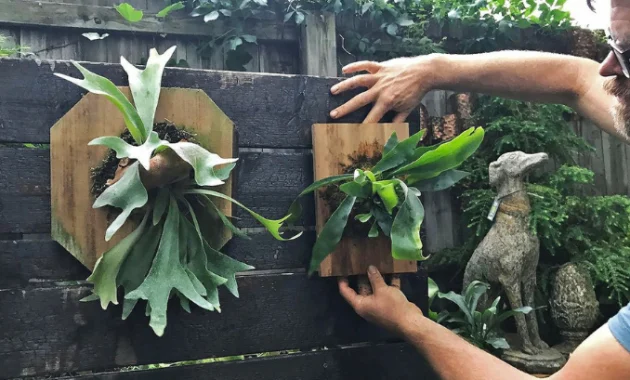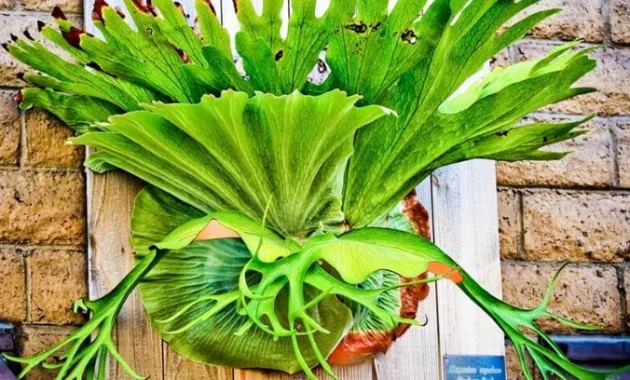Are you ready to take on the challenge of caring for a stunning staghorn fern indoors? While it may seem intimidating at first, with the right knowledge and guidance, you can create the perfect environment for your fern to thrive.
In this comprehensive guide, we will walk you through the step-by-step process of staghorn fern care indoors, ensuring that you have all the information you need to successfully nurture this fascinating plant.
Now, you might be thinking, ‘But isn’t caring for a staghorn fern difficult?’ While it’s true that staghorn ferns have specific needs, once you understand their requirements and provide the right conditions, they can actually be quite low maintenance.
With a little bit of effort and attention, you can cultivate a healthy and vibrant staghorn fern that will become a beautiful focal point in your indoor space. So, let’s dive in and explore the various aspects of staghorn fern care, including light, watering, temperature, humidity, fertilizer, and mounting techniques.
With this comprehensive guide, you’ll have all the tools you need to create an ideal habitat for your staghorn fern and ensure its long-term success.
Key Takeaways
- Indirect light is ideal for staghorn ferns indoors, but artificial grow lights can also be used.
- Consistent watering and avoiding overwatering are essential for staghorn fern care.
- Staghorn ferns thrive in temperatures between 60°F to 75°F and require humidity levels of 50% to 80%.
- Proper mounting using natural materials and regular monitoring for pests is important for staghorn fern care.

Light: Providing the Right Environment
To give your staghorn fern the light it craves, imagine it as a sun-seeking adventurer, yearning to bask in the warm rays of a tropical paradise. Staghorn ferns have specific light requirements that must be met for optimal growth. Ideally, they should be placed in a location that receives indirect light.
Direct sunlight can be too harsh and may burn the delicate fronds. However, if you don’t have access to a spot with indirect light, you can use artificial light to supplement their needs. LED grow lights are a great option as they provide the necessary spectrum of light for photosynthesis. Place the lights about 12 inches away from the fern and keep them on for about 12 to 14 hours a day. This will mimic the natural light cycle and ensure your staghorn fern thrives.
In addition to the right light conditions, it’s important to consider the watering regimen for your staghorn fern. These Platycerium plants thrive in a humid environment, so misting the fronds regularly can help maintain the necessary moisture levels. Aim to mist the fern at least once a week, focusing on the underside of the fronds where the spores are located. You can also place a tray filled with water and pebbles beneath the fern to create a humid microclimate around it.
As for watering, it’s best to water your staghorn fern when the top inch of soil feels dry to the touch. Make sure to water thoroughly, allowing the excess water to drain out. Overwatering can lead to root rot, so be cautious not to let the fern sit in standing water.
By providing the right amount of light, and following a proper watering regimen with occasional misting, you’ll create an ideal environment for your staghorn fern to flourish.
Watering: Nurturing Moisture Balance
Maintaining the perfect moisture balance is essential for your staghorn fern’s health and growth. To ensure optimal hydration, it’s crucial to establish a consistent watering schedule.
Staghorn ferns thrive in environments with high humidity, so it’s important to replicate these conditions indoors. One way to achieve this is by misting the fronds regularly with water. This helps to increase the humidity around the plant and prevents the leaves from drying out.
Additionally, you can place a tray of water near the fern to create a moist atmosphere. Monitor the moisture level of the soil by sticking your finger about an inch deep into it. If it feels dry, it’s time to water your staghorn fern.
When it comes to watering frequency, it’s better to err on the side of underwatering rather than overwatering. Overwatering can lead to root rot and other fungal diseases, which can be detrimental to the fern’s health.
Aim to water your staghorn fern about once a week during the growing season, and reduce the frequency during the winter months when the plant is dormant. However, it’s important to consider the specific needs of your fern and adjust the watering schedule accordingly.
Factors such as the size of the plant, the type of pot it’s in, and the humidity levels in your home may influence the watering frequency. Remember, it’s always better to underwater your staghorn fern than to overwater it, as it’s more tolerant of dry conditions than excessive moisture.
Temperature and Humidity: Mimicking Natural Conditions
Embrace the warmth and humidity of a tropical paradise as you recreate the ideal conditions for your green companion. Staghorn ferns thrive in a temperature range of 60°F to 75°F (15°C to 24°C), making them well-suited for indoor environments. It’s important to keep the temperature consistent and avoid extreme fluctuations, as sudden temperature changes can stress the plant.
If your home gets too cold during winter months, consider using a space heater or placing the fern near a heat source, such as a radiator, to maintain the desired temperature.
In addition to temperature, humidity plays a crucial role in the health of your staghorn fern. These ferns are accustomed to the high humidity found in tropical forest canopies, so it’s essential to mimic these conditions as closely as possible. Aim for a humidity level of 50% to 80% to provide the fern with the moisture it needs.
You can increase humidity by misting the fronds regularly or placing the fern on a tray filled with pebbles and water. Another option is to use a humidifier in the room where the fern is located. By creating a humid microclimate, you’re ensuring that your staghorn fern thrives in an environment that closely resembles its natural habitat.
Remember, these plants aren’t cold-hardy plants, so maintaining the right temperature and humidity is vital for their overall well-being.

Fertilizer: Fueling Growth
Fueling growth, proper fertilization is essential for the health and vitality of your staghorn fern. As part of your comprehensive guide to staghorn fern care indoors, it’s crucial to understand the importance of fertilizer. Fertilizer provides the necessary nutrients for your fern to thrive and develop.
When it comes to choosing the right fertilizer for your staghorn fern, opt for a balanced formula that contains nitrogen, phosphorus, and potassium. These macronutrients are essential for overall plant growth and development. Look for a slow-release fertilizer that will provide a steady supply of nutrients over time.
Applying fertilizer every four to six weeks during the growing season is recommended while reducing or stopping fertilization during the dormant period in winter.
To apply the fertilizer, dilute it to half the recommended strength and water your fern thoroughly. Apply the diluted fertilizer evenly over the surface of the fern’s shield fronds, avoiding contact with the roots. This will ensure that the nutrients are absorbed through the leaves.
Monitor the fern’s response to the fertilizer and adjust the frequency or amount as needed. Remember to always follow the instructions on the fertilizer packaging and avoid over-fertilizing, as it can lead to nutrient burn and damage to your staghorn fern.
With proper fertilization, your staghorn fern will have the fuel it needs to grow vigorously and thrive indoors.

Mounting: Creating an Ideal Habitat
Creating an ideal habitat for your staghorn fern includes the important step of mounting, with studies showing that ferns mounted on natural materials such as tree bark have a higher survival rate. Mounting provides the fern with a stable and natural environment that closely mimics its natural habitat in the wild.
When choosing a mounting material, it’s crucial to select a sturdy and porous material that’ll allow the fern’s roots to attach and grow. Tree bark is an excellent choice as it provides a rough surface for the fern to attach to and allows air circulation around the roots. Other suitable materials include cork, wooden plaques, or even coconut husks.
To mount your staghorn fern, follow these steps:
- Select a suitable mounting material, such as tree bark or cork.
- Prepare the mounting material by soaking it in water until it becomes saturated.
- Place the fern on the mounting material, ensuring that the roots are in contact with the surface.
- Secure the fern to the mounting material using wire, fishing line, or plant ties. Be gentle to avoid damaging the roots.
- Hang or attach the mounted fern in a location that provides the right amount of light and humidity for optimal growth.
To learn all about this process, check out our guide on how to mount staghorn ferns..
Remounting staghorn ferns is necessary every few years as the fern grows and outgrows its current mount. Signs that your fern needs remounting include roots growing out of the mount or the mount becoming overcrowded with leaves.
When remounting, carefully remove the fern from its current mount, taking care not to damage the roots. Gently clean off any old mounting material and trim any damaged or dead roots. Then, follow the same mounting steps outlined above to provide your staghorn fern with a fresh and ideal habitat for continued growth and vitality.
Common Issues and Troubleshooting
If you notice brown or black fronds on your staghorn fern, it could be a sign of inadequate watering or excessive sunlight.
Yellowing fronds, on the other hand, may indicate nutrient deficiencies or overwatering.
Pest infestation is another common issue, with mealybugs and scale insects being the most common culprits.
Lastly, if you find that the fronds of your staghorn fern are losing their grip and slipping from their mount, it may be due to improper mounting techniques or a lack of support.
1. Brown or Black Fronds
Despite the beauty of the staghorn fern, the presence of brown or black fronds can indicate a potential problem that needs attention. Proper staghorn fern care indoors is essential to prevent the occurrence of brown or black fronds.
Brown fronds are often a sign of underwatering or lack of humidity. To remedy this issue, make sure to water your staghorn fern regularly and provide it with the right amount of humidity. It’s recommended to water the fern once a week, allowing the water to fully saturate the root ball. Additionally, misting the fronds with water every few days can help increase humidity levels. If the fern isn’t receiving enough humidity, consider placing it near a humidifier or in a bathroom or kitchen where moisture levels are naturally higher.
On the other hand, black fronds can be an indication of overwatering or poor drainage. To prevent black fronds, ensure that your staghorn fern is potted in a well-draining medium, such as a mixture of sphagnum moss and orchid bark. Excess water should be able to drain freely from the pot to avoid waterlogged roots. If you notice black fronds, it’s important to act promptly. Remove any affected fronds and adjust your watering routine accordingly. Allow the soil to dry out slightly between waterings to prevent further root rot.
By addressing these issues and providing the appropriate care, you can help your staghorn fern thrive and maintain its lush, green fronds.
2. Yellowing Fronds
If you’ve noticed brown or black fronds on your staghorn fern, it’s important to address the issue promptly to ensure the overall health of the plant. However, another issue that may arise with staghorn ferns is yellowing fronds. Yellowing fronds can be a sign of various problems, including nutrient deficiencies, overwatering, or inadequate lighting. It’s crucial to identify the cause of the yellowing and take appropriate action to restore the fern’s vibrant green foliage.
When it comes to staghorn fern care indoors, yellowing fronds can be a common concern. To address this issue, it is important to consider the specific requirements of these unique foliage plants. First and foremost, ensure that your fern is receiving adequate light. Staghorn ferns thrive in bright, indirect light, so placing them near a north or east-facing window is ideal. Additionally, make sure that the fern is not receiving direct sunlight, as this can scorch the leaves and lead to yellowing.
To provide the optimal soil conditions for your staghorn fern, use a well-draining potting mix that is specifically formulated for ferns. This will help prevent waterlogged soil, which can lead to root rot and yellowing fronds. It’s also important to water your fern properly. Allow the top inch or so of soil to dry out between waterings, and be sure to water thoroughly, allowing excess water to drain out of the pot. Overwatering can suffocate the roots and cause yellowing of the fronds. Finally, consider supplementing your staghorn fern with a balanced liquid fertilizer every few months to ensure it’s receiving the necessary nutrients for healthy growth.
To summarize, yellowing fronds in staghorn ferns can be a sign of various issues, including inadequate lighting, overwatering, or nutrient deficiencies. By providing the right amount of light, well-draining soil, proper watering techniques, and occasional fertilization, you can help your staghorn fern thrive and maintain its vibrant green foliage.
3. Pest Infestation
When dealing with a pest infestation in your staghorn fern, you’ll need to be as vigilant as a hawk to protect your plant’s health.
Pests and diseases can wreak havoc on your staghorn fern and hinder its growth. The most common pests that attack staghorn ferns include scale insects, mealybugs, and aphids. These tiny creatures can infest your plant, sucking the sap and causing yellowing or wilting of the fronds.
To combat these pests, you can start by physically removing them with a soft brush or cloth. Make sure to inspect both sides of the fronds and the basal shield, as pests tend to hide in these areas. If the infestation is severe, you may need to resort to using insecticidal soap or horticultural oil. Follow the instructions on the product carefully and apply it to the affected areas, ensuring full coverage.
Regularly monitoring your staghorn fern for any signs of pests is crucial for keeping them at bay.
In addition to pests, it’s important to consider other factors that can affect the health of your staghorn fern. Fertilizing staghorn ferns is essential for their optimal growth. These epiphytic plants derive nutrients from the air and rain, so they don’t require frequent fertilization. However, providing them with a balanced liquid fertilizer once every few months can help promote their overall well-being.
When fertilizing, dilute the fertilizer to half or a quarter of the recommended strength to avoid overfeeding.
Another crucial aspect of staghorn fern care is proper mounting. As epiphytes, staghorn ferns naturally grow on trees in their native habitat. When mounting your staghorn fern, use a sturdy base such as a wooden plaque or a wire mesh. Ensure that the mounting material is securely attached to prevent any damage to the plant.
By paying attention to these aspects of staghorn fern care, you can ensure a healthy and thriving plant that will bring beauty to your indoor space.
4. Fronds Losing Their Grip
One thing to watch out for is fronds losing their grip, which can be a concerning issue for staghorn fern owners. Staghorn ferns, also known as stag plants, are unique in their growth pattern, with their fronds growing in a circular fashion. The fronds of staghorn ferns have specialized structures called rhizomes, which help them attach to trees or other surfaces in their natural habitat. However, when kept indoors as part of an air plant collection or in a hanging display, staghorn ferns may struggle to maintain their grip.
To better understand the issue of fronds losing their grip, let’s take a closer look at the anatomy of a staghorn fern frond. The frond of a staghorn fern consists of three main parts: the basal shield, the fertile frond, and the sterile frond. The basal shield is the part that attaches the frond to the mounting surface, while the fertile frond produces spores for reproduction, and the sterile frond provides support and photosynthesis.
When fronds lose their grip, it can be due to a few reasons. Firstly, inadequate humidity levels can cause the fronds to dry out and detach from the surface. Staghorn ferns thrive in high-humidity environments, so it is important to regularly mist or provide a humidifier to maintain the ideal moisture levels.
Additionally, improper mounting or positioning of the fern can also lead to fronds losing their grip. It is crucial to ensure that the basal shield is securely attached to the mounting surface, allowing the fern to establish a strong hold.
Finally, overwatering can cause root rot, weakening the attachment of the fronds. By properly watering the staghorn fern and allowing the roots to dry out between waterings, you can help prevent fronds from losing their grip and ensure the health of your staghorn fern.
FAQs about Staghorn Fern Care Indoors
Can staghorn ferns tolerate direct sunlight?
Yes, staghorn ferns can tolerate direct sunlight, but it is best to provide them with bright, indirect light to prevent their fronds from getting burnt. Direct sunlight for a few hours a day is acceptable.
How often should I water my staghorn fern?
Water your staghorn fern judiciously, like a skilled gardener caresses a delicate orchid. Allow the top inch of soil to dry before watering, ensuring the roots receive a thorough soak. Aim for a moist, but not soggy, environment.
What is the best temperature range for staghorn ferns?
The best temperature range for staghorn ferns is between 60-75°F (15-24°C). They thrive in a warm and humid environment, so it’s important to keep them away from drafts and extreme temperature fluctuations.
Can I use regular houseplant fertilizer for my staghorn fern?
Yes, you can use regular houseplant fertilizer for your staghorn fern. It’s important to dilute it to half-strength and apply it every two months during the growing season.
Are there any specific mounting materials that work best for staghorn ferns?
The best mounting materials for staghorn ferns are wooden plaques or boards, tree fern fiber, or wire baskets lined with sphagnum moss. These materials provide stability and a suitable substrate for the fern’s roots to attach to.
Conclusion
In conclusion, mastering the art of staghorn fern care indoors is no easy feat. It requires dedication, precision, and a touch of green thumb magic.
But fear not, intrepid plant enthusiasts, for the rewards are extraordinary. Picture yourself basking in the glory of a lush, thriving staghorn fern, its magnificent fronds cascading with grace and vigor. Your friends will gasp in awe, your neighbors will envy your horticultural prowess. You will be hailed as the ultimate plant whisperer, the guardian of botanical beauty.
But achieving this level of staghorn fern mastery is not for the faint of heart. You must create the perfect environment, a haven of gentle light and balanced moisture. You must meticulously monitor temperature and humidity, replicating the fern’s natural habitat with unwavering dedication. You must nourish it with the finest fertilizers, fueling its growth with scientific precision. And above all, you must mount it in a way that creates an ideal habitat, ensuring that it thrives and flourishes in your care.
So, dear plant aficionados, if you dare to embark on this magnificent journey, prepare to be amazed. The staghorn fern will reward your efforts with its sheer beauty and elegance. It will become the centerpiece of your indoor oasis, a living work of art that captivates all who lay eyes upon it.
But be warned, this is not a task for the feeble-hearted. It requires commitment, perseverance, and a deep understanding of the intricate needs of this remarkable plant. So, go forth, brave horticultural warriors, and conquer the world of staghorn fern care indoors!


